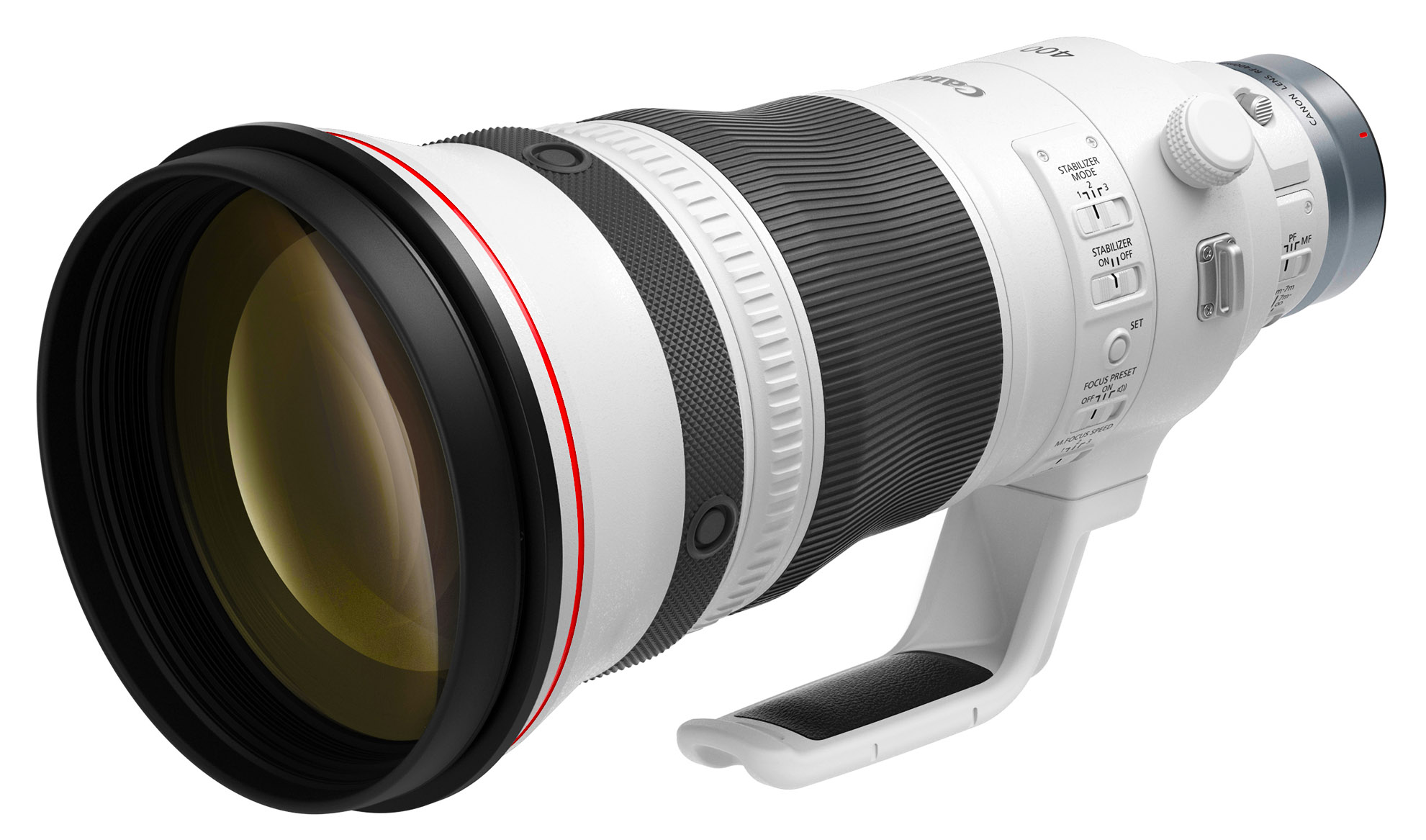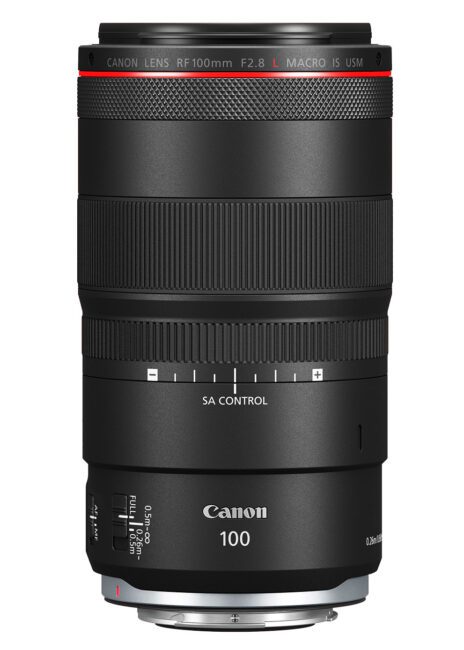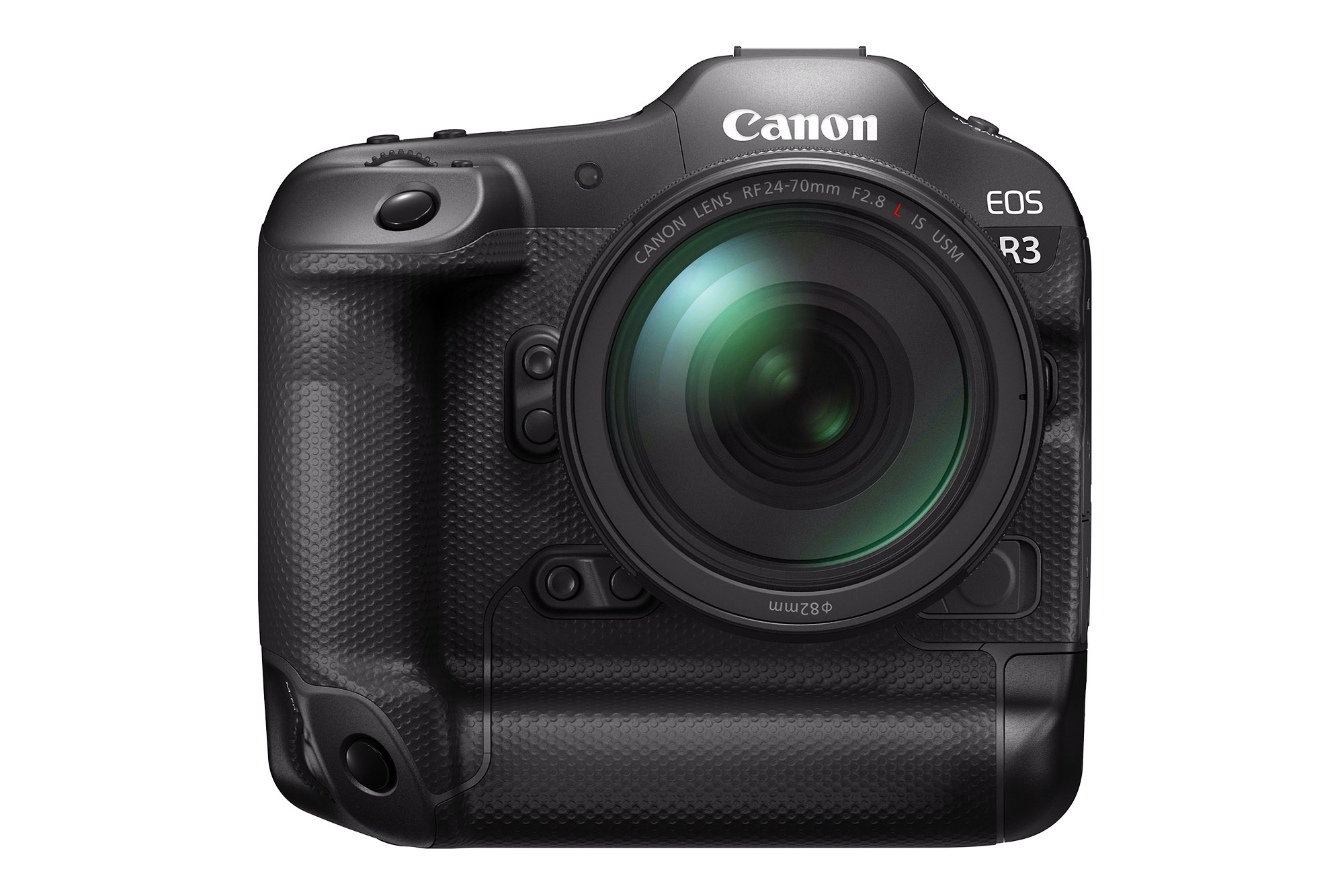Canon has announced three new mirrorless lenses – a 400mm f/2.8, 600mm f/4, and 100mm f/2.8 macro – as well as the development of the EOS R3, a pro-grade mirrorless camera with a built-in battery grip and 30 FPS shooting. The macro lens and the R3 in particular have some unusual, promising features that we at Photography Life cannot wait to test!
400mm f/2.8 and 600mm f/4

The first two lenses in Canon’s set of announcements are supertelephoto beasts: a 400mm f/2.8L costing $12,000, and a 600mm f/4L costing $13,000 (the same prices as the EF mount versions of these lenses, released in late 2018).
It was only a matter of time before Canon filled out its mirrorless supertelephoto lineup with some large-aperture lenses, and now’s a good time for this announcement considering that the Tokyo Olympics are just a few months away. These aren’t Canon’s first mirrorless supertelephotos – the company already has a 600mm f/11, 800mm f/11, and 100-500mm, f4.5-7.1 – but these are the first with such wide maximum apertures. For sports and wildlife photographers working in low light conditions, or just wanting to capture a shallower depth of field, there’s good reason to drool over those large apertures of f/2.8 and f/4.
Compared to Canon’s DSLR 400mm f/2.8 and 600mm f/4 lenses, there aren’t any new features on the RF versions, aside from the native RF mount. Canon even says that the two new lenses have the same optics as the EF mount lenses, and they also weigh almost exactly the same. The RF 400mm f/2.8 is going to weigh 6.37 pounds (2.89 kg) and the RF 600mm f/4 will weigh 6.81 pounds (3.09 kg). They’re both a negligible 2 ounces (50 grams) heavier than their DSLR counterparts, thanks to the additional length of the lens barrel, which is needed in order to fit the RF mount.
All these similarities aren’t a bad thing, in part because Canon’s DSLR versions of these lenses are already excellent. And since Canon is pushing so much in the direction of mirrorless these days, it’s really important for them to flesh out the RF supertelephoto lineup. I’m sure these two lenses are going to have a very devoted audience.
100mm f/2.8 Macro

The other lens that Canon just announced is perhaps even more interesting. It’s a 100mm f/2.8 macro lens, and it’s also the first autofocus macro lens from any company that natively goes beyond 1:1, AKA “life size,” magnification.
The RF 100mm f/2.8L goes to 1.4× magnification, which is substantial. Typical macro lenses go up to 1× magnification, which means, on a full frame camera sensor, you would be able to fill the photo with something 1.5 inches (36 millimeters) across. This one, at 1.4×, lets you fill the frame with something about 1 inch (25 millimeters) instead. You can still use extension tubes, close-up filters, or teleconverters to increase your magnification further, but the key is that the new Canon focuses closer by default, without any of those extra attachments.
The other headlining feature on the RF 100mm f/2.8 is that it has a spherical aberration control ring (labeled “SA”) that allows you to control the look of the out-of-focus areas in the foreground and background. It should function similarly to the “defocus control” on a couple older lenses from Nikon (the 105mm and 135mm DC lenses), where you have the ability to over- or under-correct spherical aberrations in the image. The result can be some extremely pleasant bokeh on the Nikons, and hopefully this new Canon will follow suit. It’s the first macro lens to have this capability. It’s a bit pricy at $1400, but that’s not a huge surprise considering the unique features. Personally, as a macro photographer, I’m very excited to try it out.
Canon EOS R3 Development

The other announcement isn’t quite a fully-fledged product just yet, but instead is more along the lines of a teaser for a future product (similar to what Nikon did when announcing the Z9’s development about a month ago). It’s the Canon EOS R3, a pro-level mirrorless camera targeted at the likes of Sony’s A9 series and the upcoming Nikon Z9.
Because the EOS R3 was simply a development announcement, we don’t know all the details about the camera yet. Here’s what we do know so far:
- Canon’s first stacked CMOS sensor, with backside illumination
- 30 FPS stills shooting with full autofocus and auto exposure, using the electronic shutter
- Electronic shutter redesigned for less rolling shutter
- Eye-sensing autofocus that notes where the photographer is looking and positions the focusing point in that area
- Integrated vertical grip, and weather resistance “equivalent to that of EOS-1D class cameras,” according to Canon
- Canon says it is “positioned squarely between the EOS R5 and EOS-1D X Mark III cameras,” which still leaves some space at the top of Canon’s RF lineup for the rumored EOS R1
That’s more information than we sometimes get with a development announcement, and it shows that Canon is serious about making the R3 a capable camera for fast action photography. Although we don’t know the R3’s resolution yet, the 30 FPS shooting will need to move a massive amount of data per second, and likely wouldn’t have been possible without Canon’s choice of a fast-readout stacked CMOS sensor.
Even more than the 30 FPS shooting figure, I can’t wait to see how well the eye-sensing autofocus will work. If it’s accurate and fast, this technology has the potential to be a game-changer across the camera world – not just Canon, and not just mirrorless. Other manufacturers will need to add it to their cameras or risk losing market share to a technology that almost automatically puts the focusing point in the correct spot.
We don’t know all the details about the eye-sensing autofocus yet, but Canon’s press release has a bit of an explainer. Here’s what it says:
The Electronic Viewfinder of the EOS R3 will offer photographers the ability to select the initial area for AF tracking by simply looking directly at the viewfinder location where they want to begin AF. With Eye Control AF and Servo AF activated, the camera will focus on and track moving subjects at that location in the frame. When Face Detect + Tracking is active, the camera will continue to follow moving subjects around the entire active AF area.
So, it seems that the eye-sensing AF on the EOS R3 is more about finding the correct starting point for autofocus, and may not yet be capable of tracking a subject across the frame as the photographer merely looks at it move. But we won’t know the details for sure until the EOS R3 finds its way into the hands of professionals, so be on the lookout for more information soon.
Press Release
Canon’s full press release for these three lenses and the EOS R3 development is as follows:
Developing News: Canon Announces That The Powerful Professional Full-Frame EOS R3 Mirrorless Camera Is On Its Way
The Company Is Also Welcoming Three New RF Lenses: The Canon RF100mm F2.8 L Macro IS USM, RF400mm F2.8 L IS USM and RF600mm F4L IS USM
MELVILLE, NY, April 14, 2021 – Canon U.S.A. Inc., a leader in digital imaging solutions, today announced that its parent company, Canon Inc., is developing a new, high-performance professional camera — the Canon EOS R3*. When it arrives, the EOS R3 will be an outstanding complement to the three new RF lenses the company also introduced today — The Canon RF 100mm F2.8 L Macro IS USM, RF400mm F2.8 L IS USM and RF600mm F4 L IS USM.
“The development of the Canon EOS R3 and the launch of the new RF lenses are the latest testament to the company’s commitment to professional still and video image and content creators,” said Tatsuro “Tony” Kano, executive vice president and general manager of Canon U.S.A.’s Imaging Technologies & Communications Group. “When the camera becomes available, it will pair well with each of the new RF lenses announced today. Canon is excited to share this news today, and we look forward to seeing the images captured with the new RF lenses and upcoming EOS R3.”
Under Development – The Canon EOS R3
The Canon EOS R3 will join the current lineup of EOS R full-frame mirrorless series cameras. This camera will usher in a new category to the EOS R system, positioned squarely between the EOS R5 and EOS-1D X Mark III cameras. The camera will put great emphasis on superb AF performance and speed, with fast-moving subjects. It is being designed to meet the reliability and durability demands of professionals, even when working in challenging conditions.At the heart of the EOS R3 camera’s performance will be an EOS camera first, a Canon-developed, full-frame stacked CMOS sensor with a back-illuminated design, providing substantially faster read-out speeds during still-imaging recording. This completely new sensor is designed to produce less “rolling shutter” distortion during Electronic Shutter operation and offer continuous Electronic Shutter still-image shooting at speeds up to 30 fps — with full Dual Pixel CMOS AF and auto exposure1.
The AF system will leverage technology and performance from the well-received EOS R5 and EOS R6 cameras, using Deep Learning technology to further enhance eye and body detection for even better performance during portrait and action-type shooting. In addition, the EOS R3’s subject detection AF will offer new recognizable subjects for its AF system, bolstering its focusing capabilities during challenging shooting conditions.
The Electronic Viewfinder of the EOS R3 will offer photographers the ability to select the initial area for AF tracking by simply looking directly at the viewfinder location where they want to begin AF. When using the Electronic Viewfinder of the EOS R3 Eye Control AF2 will offer photographers the ability to select the initial area for AF tracking by simply looking directly at the viewfinder location where they want to begin AF.
The camera body will be entirely new and accentuates the camera’s high-performance design. It’s a one-piece design, integrating the body with a vertical grip section. The weather and dust-resistance will be equivalent to that of EOS-1D class cameras — an essential consideration for nature, wildlife, sports and photojournalism content creators working in extreme conditions. In addition, news photojournalists will be excited to add the Mobile File Transmitter application for iOS and Android devices that will be available.
Full details of all the EOS R3’s features and specifications will be provided at the time of its formal announcement*. To follow along for more news on the Canon EOS R3 camera, please visit: www.usa.canon.com/eosr3.
From Up-Close To Far Away, New Canon RF Lenses Have You Covered
The Canon RF100mm F2.8 L Macro IS USM lens is not only Canon’s first RF lens designed specifically for macro photography, but also the world’s first3 medium telephoto macro lens with a maximum magnification of 1.4x. The new lens, designed for both advanced photo enthusiasts and professionals, takes macro photography expression to the next level with the introduction of a spherical aberration (SA) control ring. The SA control ring allows users to change the character and appearance of the bokeh and obtain a softer focus effect with a simple turning of the ring to the desired result. Additional features of the Canon RF100mm F2.8L Macro IS USM include:
- Optical Image Stabilizer with up to five stops of Shake Correction4.
- When combined with a camera featuring In-Body Image Stabilizer, up to eight stops of shake correction5 is possible with coordinated operation of Optical and In-Body Image Stabilizer.
- Hybrid IS helps to compensate for angular and shift camera shake during macro shooting.
- High-speed, smooth and quiet auto focus with dual nano USM.
- Customizable control ring that allows photographers to adjust exposure compensation, shutter speed, aperture or ISO.
- Rugged Canon L-series dust and water-resistant design.
The Canon RF400mm F2.8L IS USM and Canon RF600mm F4L IS USM are both designed to be optically identical to their EF counterparts. The RF400mm and RF600mm weigh in at 6.37 and 6.81 pounds with a minimum focusing distance of 8.2 and 13.8 feet, respectively. Both lenses share many of the same critical features that help professional high-end super-telephoto lenses stand out from the crowd. Those features include:
- Ideal for a wide variety of shooting situations, including sports, aviation, trains, automotive, and wildlife, such as birding.
- Optical Image Stabilization with up to 5.5 stops6 of shake correction. Including three IS Operation Modes — still subjects, panning, and irregular movement.
- Proprietary Canon lens coatings, Super Spectra Coating (SSC), and Air Sphere Coating (ASC) help minimize ghosting and flaring. Lens placement and coatings are optimized to provide users with clear, high-contrast images even when there is a bright light source.
- Lenses include fluorite and super UD lens elements arranged in such a way to help correct chromatic aberration and make the models more compact. Like the latest Canon EF400mm f/2.8L IS III USM and EF600mm f/4L IS III USM lenses, released in the fall of 2018, weight on these RF-series super-telephotos has been significantly reduced vs. previous-generation Canon super tele designs.
- Compatible with Canon RF 1.4x and 2x extenders, and feature a customizable electronic focus ring, with manual focus capability during SERVO AF.
- A nine-blade circular aperture provides users beautiful bokeh and ideally blurred backgrounds when the aperture is stopped down.
- For added convenience when on a shoot, two focus presets are available. Users can instantly return to one of two memorized focus distances.
- Rugged Canon L-series dust and water-resistant design with vibration and shock resistance. The front element has been dressed with a fluorine coating for easy cleaning.
- Infrared reflective pigments with high reflectance and titanium oxide lens barrel coating with silica provide excellent UV weather resistance and heat reduction.
Canon RF Lenses Pricing and Availability
The Canon RF100mm F2.8 L Macro IS USM, Canon RF400mm F2.8 L IS USM and Canon RF600mm F4L IS USM are scheduled to be available in July 2021 for an estimated retail price of $1,399.00, $11,999.00 and $12,999.00, respectively*. For more information, please visit usa.canon.com.About Canon U.S.A., Inc.
Canon U.S.A., Inc., is a leading provider of consumer, business-to-business, and industrial digital imaging solutions to the United States and to Latin America and the Caribbean markets. With approximately $30.4 billion in global revenue, its parent company, Canon Inc. (NYSE:CAJ), ranks third overall in U.S. patents granted in 2020† and is one of Fortune Magazine’s World’s Most Admired Companies in 2020. Canon U.S.A. is dedicated to its Kyosei philosophy of social and environmental responsibility. To keep apprised of the latest news from Canon U.S.A., sign up for the Company’s RSS news feed by visiting www.usa.canon.com/rss and follow us on Twitter @CanonUSA.# # #
†Based on weekly patent counts issued by United States Patent and Trademark Office.
* Specifications and availability are subject to change without notice.
1 Continuous shooting speed may decrease, depending upon lens in use, and shooting conditions.
2Eye Control AF may not be available, depending upon differences with individual users, or the shooting environment. In addition, Eye Control AF may not be possible with certain sunglasses, mirror sunglasses, hard contact lenses, or bifocal eyeglass lenses.
3As an autofocus interchangeable lens for full-frame mirrorless cameras. Canon survey as of April 14, 2021.
4Based on CIPA (Camera & Imaging Products Association) standards. Testing performed using the EOS R camera.
5 Based on CIPA (Camera & Imaging Products Association) standards. Testing performed using the EOS R5 camera.
6 Based on CIPA (Camera & Imaging Products Association) standards. Testing performed using the EOS R camera.